Valve is well known for keeping any information about its hardware plans very tightly under wraps, to the point where you might as well hire the world’s best psychic to forecast when something new is on its way. But never underestimate the sheer diligence of tech enthusiasts, especially the likes of Brad Lynch, who’s spotted some interesting snippets of potential changes or updates for the Steam Deck.
His recent posts (as reported by The Verge) revolve around the so-called Model 1030 which looks to be a clear update of some kind for Valve’s handheld gaming PC. It’s worth pointing out that no matter what—if any—changes are forthcoming, 1030 is absolutely not a Steam Deck 2. Valve has been crystal clear on this matter, so if you’re hoping that something with more performance is just around the corner, you’re in for a long wait.
But what would Valve actually change? The Steam Deck comprises multiple components from lots of different vendors, so it could well just be a case of new suppliers being involved. Or it could be a switch to parts with different specifications or dimensions that are simply cheaper for Valve to purchase.
One scenario would be a raft of new bits and bobs that all add up to a reduced power consumption, all of which would mean a longer battery life. Another would include a new display panel, but it’s unlikely to be any better, just cheaper. Worst case? Just the ancillary parts are being updated, to the point where you wouldn’t be able to tell the difference between the refreshed model and the original one.
The general expectation seems to be that it’s just the Wi-Fi module that’s being updated and that it potentially might result in the refreshed model sporting Wi-Fi 6E capability. Is that something the Steam Deck really needs, in the grand scheme of things? Answers on a postcard, please.
(Image credit: Future)
Steam Deck review: Our verdict on Valve’s handheld.
Best Steam Deck accessories: Get decked out.
Steam Deck battery life: What’s the real battery life?
Given that it’s the custom AMD APU that has the biggest demand on the battery’s available power, an updated version of that would be the best way to keep gaming longer. But this means AMD would need to have it manufactured on a different process node or heavily redesigned, and that could end up making it more expensive for Valve to purchase.
Personally, I wouldn’t get too excited about all of this news. It’s interesting stuff, of course, but I can’t see any sign of a noticeably better Steam Deck on its way. There again, I am the world’s worst psychic and I will gladly eat a caramel cookie if it turns out that Valve is, once again, going to surprise us all with something more potent than a straight refresh.











